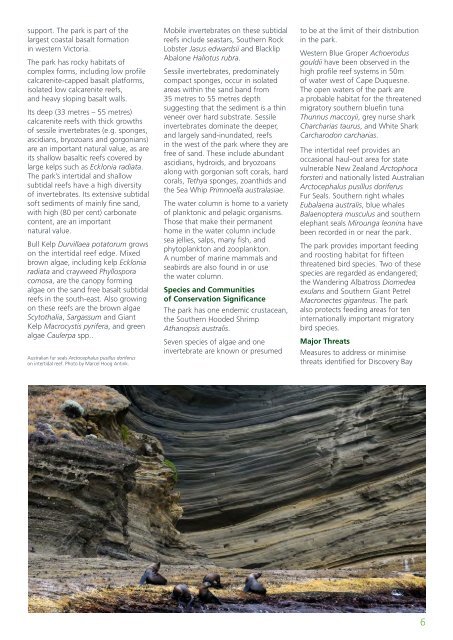Marine Natural Values Study Summary - Parks Victoria
Marine Natural Values Study Summary - Parks Victoria
Marine Natural Values Study Summary - Parks Victoria
You also want an ePaper? Increase the reach of your titles
YUMPU automatically turns print PDFs into web optimized ePapers that Google loves.
support. The park is part of thelargest coastal basalt formationin western <strong>Victoria</strong>.The park has rocky habitats ofcomplex forms, including low profilecalcarenite-capped basalt platforms,isolated low calcarenite reefs,and heavy sloping basalt walls.Its deep (33 metres – 55 metres)calcarenite reefs with thick growthsof sessile invertebrates (e.g. sponges,ascidians, bryozoans and gorgonians)are an important natural value, as areits shallow basaltic reefs covered bylarge kelps such as Ecklonia radiata.The park’s intertidal and shallowsubtidal reefs have a high diversityof invertebrates. Its extensive subtidalsoft sediments of mainly fine sand,with high (80 per cent) carbonatecontent, are an importantnatural value.Bull Kelp Durvillaea potatorum growson the intertidal reef edge. Mixedbrown algae, including kelp Eckloniaradiata and crayweed Phyllosporacomosa, are the canopy formingalgae on the sand free basalt subtidalreefs in the south-east. Also growingon these reefs are the brown algaeScytothalia, Sargassum and GiantKelp Macrocystis pyrifera, and greenalgae Caulerpa spp..Australian fur seals Arctocephalus pusillus doriferuson intertidal reef. Photo by Marcel Hoog Antink.Mobile invertebrates on these subtidalreefs include seastars, Southern RockLobster Jasus edwardsii and BlacklipAbalone Haliotus rubra.Sessile invertebrates, predominatelycompact sponges, occur in isolatedareas within the sand band from35 metres to 55 metres depthsuggesting that the sediment is a thinveneer over hard substrate. Sessileinvertebrates dominate the deeper,and largely sand-inundated, reefsin the west of the park where they arefree of sand. These include abundantascidians, hydroids, and bryozoansalong with gorgonian soft corals, hardcorals, Tethya sponges, zoanthids andthe Sea Whip Primnoella australasiae.The water column is home to a varietyof planktonic and pelagic organisms.Those that make their permanenthome in the water column includesea jellies, salps, many fish, andphytoplankton and zooplankton.A number of marine mammals andseabirds are also found in or usethe water column.Species and Communitiesof Conservation SignificanceThe park has one endemic crustacean,the Southern Hooded ShrimpAthanopsis australis.Seven species of algae and oneinvertebrate are known or presumedto be at the limit of their distributionin the park.Western Blue Groper Achoerodusgouldii have been observed in thehigh profile reef systems in 50mof water west of Cape Duquesne.The open waters of the park area probable habitat for the threatenedmigratory southern bluefin tunaThunnus maccoyii, grey nurse sharkCharcharias taurus, and White SharkCarcharodon carcharias.The intertidal reef provides anoccasional haul-out area for statevulnerable New Zealand Arctophocaforsteri and nationally listed AustralianArctocephalus pusillus doriferusFur Seals. Southern right whalesEubalaena australis, blue whalesBalaenoptera musculus and southernelephant seals Mirounga leonina havebeen recorded in or near the park.The park provides important feedingand roosting habitat for fifteenthreatened bird species. Two of thesespecies are regarded as endangered;the Wandering Albatross Diomedeaexulans and Southern Giant PetrelMacronectes giganteus. The parkalso protects feeding areas for teninternationally important migratorybird species.Major ThreatsMeasures to address or minimisethreats identified for Discovery Bay6
















